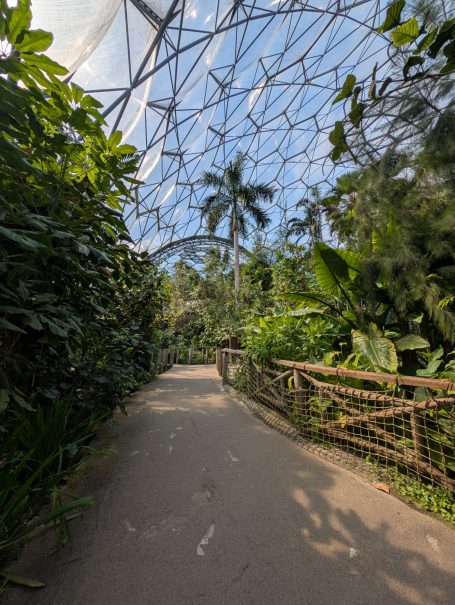Travel Tips: Eden Project, Cornwall
Step into a living theatre of plants and people at the extraordinary Eden Project in Cornwall. More than just a garden, this captivating destination immerses you in the wonders of biodiversity, showcasing stunning biomes that recreate rainforest and Mediterranean environments. Prepare to be inspired by the power of nature and the interconnected life on Earth. Let me help you plan your visit to this unique and unforgettable Cornish experience.
History of the eden project
The Eden Project in Cornwall, UK, is a world-renowned ecological attraction built in a reclaimed china clay pit near St Austell.
Its history began in the mid-1990s when archaeologist and anthropologist Tim Smit (also known for restoring the Lost Gardens of Heligan) conceived the idea. He envisioned transforming the barren industrial site into a massive garden showcasing the vital relationship between plants, people, and resources.
Construction started in 1998 on the ambitious project, designed by architect Nicholas Grimshaw and engineering firm Anthony Hunt & Associates. The most striking features are the iconic geodesic domes (biomes), constructed from tubular steel and ETFE (ethylene tetrafluoroethylene) panels, which are inspired by soap bubbles to adapt to the uneven ground.
The Eden Project officially opened its doors to the public on March 17, 2001. It was one of the UK's Millennium Projects, funded significantly by the Millennium Commission, and immediately became a massive success, drawing over a million visitors in its first four months.
Since its opening, the Eden Project has not only become a major tourist destination, significantly boosting Cornwall's economy, but also a leading educational charity focusing on environmental education, sustainable living, and ecological regeneration. It continues to evolve, hosting events, developing new projects, and inspiring sustainable practices globally.
Biomes @ the eden project
Rainforest biome
- The Rainforest Biome is the world's largest indoor rainforest, soaring 55 meters high, 100 meters wide, and 200 meters long. It maintains a humid, tropical climate (18C to 35C) using recycled rainwater, complete with crashing waterfalls.
- This biome features distinct zones representing rainforests from Tropical Islands, Southeast Asia, West Africa, and Tropical South America.
- It houses over 1,000 plant varieties, including vital crops like cacao, coffee, rubber, and bananas, alongside rare and iconic species such as the Titan Arum (Corpse Flower), giant bamboo, and baobab trees.
- Key experiences include a Canopy Walkway (with a "Wobbly Bridge") for high-level views, an authentic Malaysian House, and the Baobab & Rum Bar. Educational displays highlight rainforest ecosystems, deforestation issues, and the vital link between plants and people.
Mediterranean Biome
- The Mediterranean Biome, the smaller and cooler of the two, stands 35 meters high, 65 meters wide, and 135 meters long. It recreates warm temperate and arid climates (9C to 25C), featuring hot, dry summers and cool, wet winters.
- This biome showcases over 1,000 plant varieties from Mediterranean-type climates, including the Mediterranean Basin, California, South Africa (Fynbos), and Western Australia.
- Expect to see diverse plant life, from food crops like olives, grapevines, and citrus fruits to fragrant herbs like lavender and rosemary. It also features iconic blooms such as bougainvillea, protea flowers, and succulents.
- Key experiences include the Perfume Garden, a Citrus Grove, and "The Rites of Dionysus" sculpture. You can even dine within the biome at the Med Terrace Restaurant. The biome's educational focus is on plant adaptations to arid conditions and the cultural significance of these unique ecosystems.
Both biomes are constructed from a robust yet lightweight hexagonal tubular steel frame cladded with ETFE (ethylene tetrafluoroethylene) "pillows." These inflated, transparent plastic panels are lighter and more flexible than glass, allowing maximum light transmission (including UV) and acting as excellent insulators, maintaining the specific internal climates efficiently. The design, inspired by soap bubbles, allows the structures to adapt to the uneven terrain of the former clay pit.
Skywire zipline @ the eden project
The Eden Project in Cornwall is home to Skywire, England's longest and fastest zipline, operated by Hangloose Adventure.
- The Ride: Skywire sends you soaring 660 meters (over 2,100 feet) across the Eden Project's iconic biomes. You'll reach speeds of up to 60 mph in a thrilling "Superman" flying position, suspended up to 96 meters (over 310 feet) above the ground.
- Views: The ride offers unparalleled panoramic views of the Eden Project's biomes, the lush Cornish landscape, and the distant sea.
- Dual Lines: There are two parallel high wires, allowing you to share the experience alongside a friend or family member, or fly solo.
- Booking & Logistics:
- It's highly recommended to book in advance.
- There's no need for an Eden Project admission ticket to do the zipline, as Hangloose Adventure operates separately, though combined tickets are available.
- Weight restrictions typically range from 30kg (4st 10lb) to 120kg (18st 12lb), and the minimum age is usually 8 years old.
- Participants receive a safety briefing and are fitted with a harness.
- Proper attire, including closed-toe, flat shoes and clothing that covers shoulders and thighs, is required.
- The experience typically takes 40 minutes to an hour, excluding potential waiting times.
- Accessibility: Hangloose Adventure offers accessible Skywire experiences for wheelchair users upon request, often in exclusive morning slots. They also accommodate assistance dogs and provide transport on-site.
- Other Activities: Hangloose Adventure also offers other thrill-seeking activities at the Eden Project site, including the Gravity giant swing, SkyTrek (aerial trekking), and Big Air (base jump).
Planning your day @ the eden project
- Book Your Tickets in Advance: Especially during peak seasons and school holidays, booking your tickets online is highly recommended. This often saves you time and sometimes money compared to purchasing on arrival.
- Consider a Guided Tour: Guided tours can provide valuable insights into the plants, the project's mission, and the stories behind the exhibits. Check availability and booking options.
- Allow a Full Day: The Eden Project is vast and there's a lot to see and do, both indoors and outdoors. Plan to spend a full day to truly appreciate the biomes, gardens, and exhibits.
- Utilise the Park and Ride: During busy periods, parking on-site can be limited. The Eden Project operates a Park and Ride service from nearby locations, which is often the easiest way to access the site. Follow the signage.
Helpful considerations
- Wear Comfortable Shoes: You'll be doing a fair amount of walking, often on uneven terrain, so comfortable footwear is essential.
- Dress in Layers: The temperature inside the biomes can be significantly different from the outside, especially the Rainforest Biome which is warm and humid. Dressing in layers will allow you to adjust accordingly.
- Check the Weather Forecast: Cornwall's weather can be unpredictable. Check the forecast before your visit and be prepared for potential rain or sunshine, especially if you plan to explore the outdoor gardens.
- Don't Miss the Outdoor Gardens: The extensive outdoor gardens showcase a wide variety of plants from different temperate regions. Explore the different themed areas and enjoy the seasonal displays.
- Check the Daily Schedule: The Eden Project often has special events, talks, workshops, and guided tours. Check the daily schedule upon arrival or beforehand online to see if anything interests you.
- Food and Drink Options: There are various food and drink outlets throughout the Eden Project, ranging from cafes to restaurants. You can also bring your own picnic to enjoy in designated areas.
- Family-Friendly Activities: The Eden Project offers numerous activities for children, including play areas, interactive exhibits, and trails. Check for family-specific events and resources. All of the Eden Project is dog-friendly, except inside of the biomes, only service dogs are permitted within the biomes. While one of us explored the biomes, the other could comfortably wait with our dogs on the many benches located just outside. This made it easy for us to both experience the Eden Project.
Accessibility @ the eden project
Accessibility for the Gardens & Biomes
The Eden Project's accessibility guide aims to ensure a great experience for all visitors. Key provisions include:
- Free entry for carers or personal assistants.
- Accessible parking spaces and toilets.
- Free manual wheelchairs available on-site.
- Electric scooters and pushchairs (single/double) available for pre-booking (for a fee).
- For visitors with visual impairment, a Braille guide book and a text reader are available.
- While the site is built in an old clay mine with varying gradients, zig-zag paths are used to minimise steepness.
Accessibility for Skywire Zipline
Hangloose Adventure offers accessible Skywire experiences for wheelchair users upon request, often in exclusive morning slots. They also accommodate assistance dogs and provide transport on-site.
Last Updated: 31 May '25



